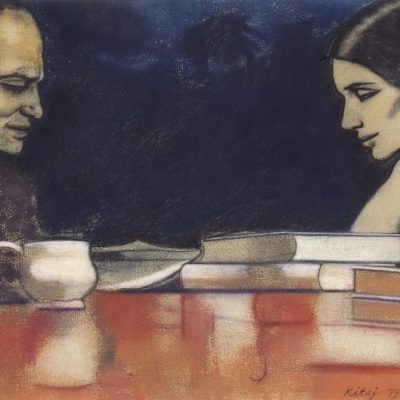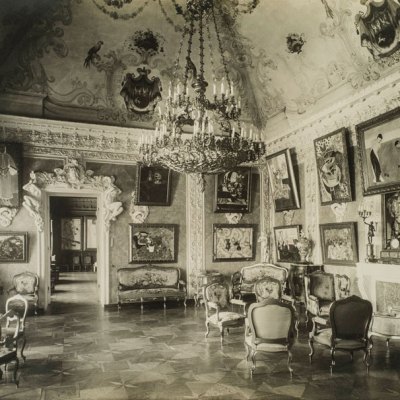For all his fame as a painter, Marc Chagall is still underrated – and to general audiences largely unknown – as a writer of both prose and poetry. The reissue of his autobiography therefore offers an opportunity to remedy this blind spot regarding one of the 20th century’s towering figures. While it can be challenging to see Chagall’s visual art with fresh eyes, especially given his appetite for repeating himself, and because of the ubiquity of his images in reproduction, his writing is unencumbered by such oversaturation. Reading his autobiography is thus not only a pleasure in itself; it also provides an orthogonal path back to his artwork, allowing us to recapture the originality of his work during his finest period, the 1910s and the 1920s.
In 1922, when Chagall sat down to compose his autobiography, he had already lived several lives. His talents had taken him from his home city of Vitebsk to St Petersburg – illegally as a Jew – and on to Paris in 1910, where he joined an extraordinary wave of talented émigrés. On the brink of the First World War he returned home to Russia. When the October Revolution struck in 1917, Chagall, like many other Jews, celebrated the dawn of a new epoch, free from Tsarist persecution. During the brief but intense period of cultural freedom in Soviet Russia that followed, he was even appointed Commissar of Art in Vitebsk. Before long, however, Chagall found his art derided as crude by the Suprematists, who favoured geometric abstraction, and denounced as dubiously ethnocentric by the Russian authorities, intent on imposing a collective identity. Caught in this vice-like grip, Chagall felt impelled to narrate his life, and legitimise his art, in his own terms. My Life is both a melancholy missive to Russia, which he would soon abandon for good, and a love letter to France, to which he longed to return.
One can sense Chagall’s internal struggle throughout the text, which oscillates between exclamations of disdain for his motherland and professions of devotion, lest he be seen as disloyal. ‘I felt that if I stayed in Vitebsk any longer,’ he writes, ‘I should be covered with hair and moss […] I am very happy with all of you. But… have you heard of traditions, of Aix, of the painter with severed ear, of cubes, of squares, of Paris? Vitebsk, I’m forsaking you. Stay on your own with your herrings!’ Russia cannot compete with the land of Cézanne, Van Gogh, or Picasso. It is no accident, though, that Chagall alludes to these modern masters without citing them by name. Though he stood spellbound by the innovations of contemporary European artists, he also cultivated a reputation as a naïf. Chagall was determined to have it both ways, placing himself at the forefront of the European art world while obscuring contemporary influences on his work. If we read his autobiography, which at times can prove a bit cloying, in the way he hoped, Chagall is a sort of prophet, destined to stand apart.
The only peers whom Chagall’s ego permits him to embrace fully are the Old Masters. Suffering pangs of homesickness when he first moved to Paris, it was the Louvre, he writes, that welcomed him with open arms and convinced him to stay. He reassures himself, in a moment of ostensible doubt, ‘I’m certain Rembrandt loves me’. Whereas Russia rejected him both as an artist and as a Jew, in Chagall’s imagination Rembrandt accepts him unconditionally on both accounts. And it is through the Dutch painter’s eyes that Chagall recalls his own past, relating his memories of his family. In a wistful passage, typical of Chagall’s poetic, impressionistic style, he writes:
Every Saturday uncle Neuch would put on a tallit, any tallit, and read the Bible aloud.
He played the violin, like a cobbler.
Grandfather listened and dreamt.
Only Rembrandt could have known what the old grandfather, butcher, tradesman and cantor thought while his son played the violin beside the window, beside the dirty windowpanes covered with raindrops and finger marks.
Just as art history drips into and defines family history, so Chagall conceives of his Dutch artistic predecessor through the metaphor of family, a concept bearing the indelible imprint – the ‘finger marks’ – of the artist’s identity as a Russian Jew.
It is for such gentle moments that Chagall’s autobiography should be read and his more contrived passages endured. The present edition also contains a smattering of Chagall’s prints and drawings, loosely related to the scenes he describes. Some of these images repeat or anticipate motifs from his paintings, and spotting these affinities will prove appealing to Chagall’s most ardent fans. Rather than standing on their own, however, their greatest merit is their contribution to Chagall’s storytelling, at a time when he was still immersed in the world of Russian Jewry. This connection, the lifeblood of his creativity, grew sadly anaemic in later years, as his link to the motherland became merely the memory of a memory – as if Chagall himself were simply reading his own autobiography for inspiration.
It is a shame that Penguin’s edition of My Life does not have a scholarly introduction, which could provide useful context for Chagall’s story, as well as a counterbalance to some of his more fanciful claims. For those who desire a deeper, more scholarly appreciation of Chagall’s evolving self-image, Benjamin Harshav’s Marc Chagall and his Times: A Documentary Narrative (2004) provides recensions of Chagall’s autobiography, as well as a raft of other documentation. And while Dorothy Williams’ 1965 translation does capture the alternating tides of whimsy and melancholy in Chagall’s narrative, it would be helpful to have annotations to signal alternative readings. Yet ultimately this book is more poetry than history, and there is a certain freedom that comes from reading it in that spirit. Besides, if there were anything that would make Chagall roll over in his grave, it would be footnotes.
My Life by Marc Chagall is published by Penguin.
From the May 2018 issue of Apollo. Preview and subscribe here.



